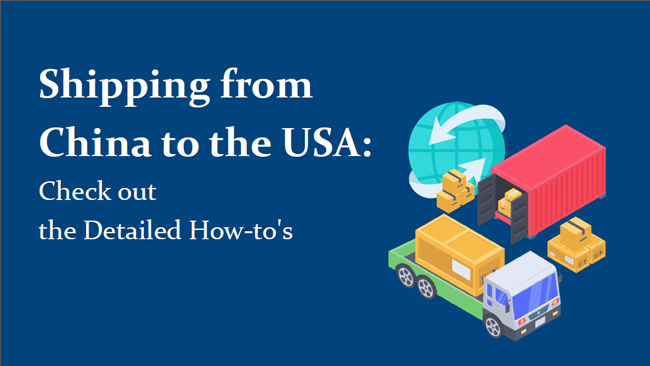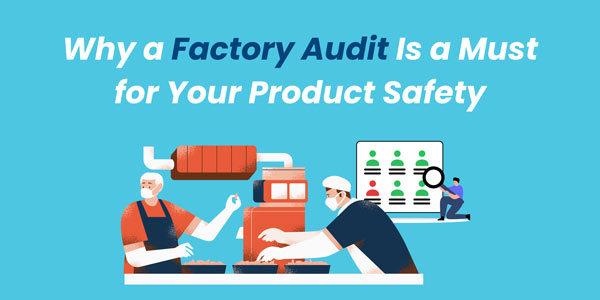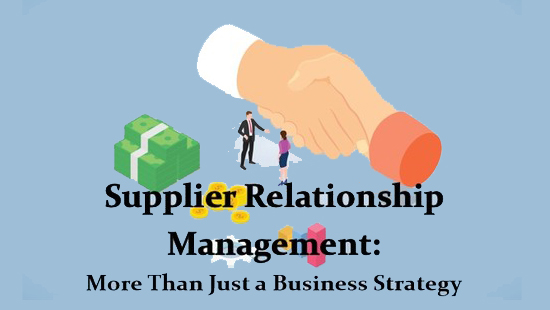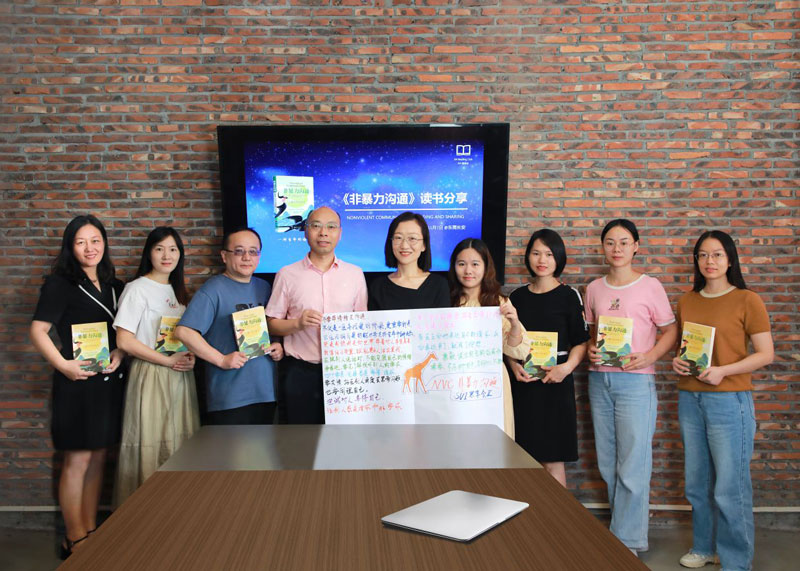What Is the Difference Between Vendor vs Supplier: Latest Guide
- Date:
- Author: SVI Content Team
- Share:
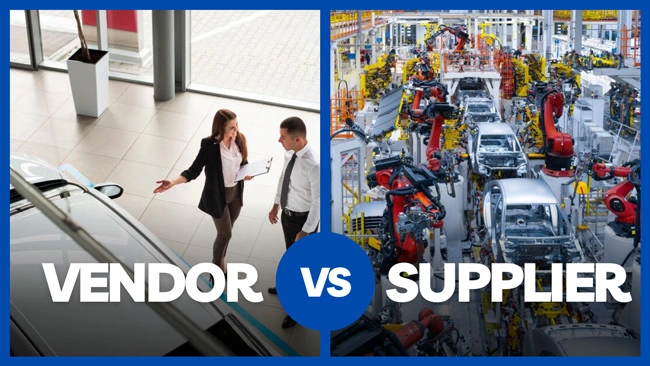
If you’re new to the field of supply chain management, you may find yourself pondering: Is a vendor the same as a supplier or What is the difference between a vendor and a supplier?
Suppliers and vendors are both essential roles within the supply chain. These terms are often used interchangeably, which is why the vendor vs supplier distinction can be confusing.
To gain a solid understanding of sourcing and supply chain strategy, a clear definition of these two terms is necessary. Our blog intends to clarify the concepts and show the difference between the two in various aspects that set suppliers and vendors apart.
Part 1. What Do Vendor vs Supplier Mean?
1) Definition
To get an idea of the distinctions between suppliers and vendors, figuring out the vendor vs supplier definition is the first thing to wade through.
✔ What Is a Vendor?
In the Cambridge Dictionary, vendor is “a person or company that sells goods or services; a person who sells food or goods on the street.”
In supply chains, a vendor, usually refers to a person or company that sells finished goods or services directly to customers, either individual consumers or businesses.
They can source products from suppliers or manufacturers and sell through brick-and-mortar stores or businesses.
Vendors are customer-oriented. They have a direct relationship with customers and focus on meeting the demands of individual consumers and businesses.
✔ What Is a Supplier?
Cambridge defines a supplier as “a company or person that provides things that people want or need, especially over a long period of time; a company that provides products or materials to make a product.”
And we usually use it to mean a business that provides goods to another business or organization. They are responsible for the sourcing and supply of raw materials, components, or finished goods to other businesses for production.
Some of them could be involved in manufacturing activities, like providing components that are integrated into the final product. They need to process the order materials first and then ship the ready-to-sell products to other enterprises for further manufacturing.
2) Traditional Supply Chain Workflow
While comparing supplier vs vendor, the word “supplier” is more commonly used in the context of the manufacturing process and business-to-business (B2B) relationships.
On the other hand, the term “vendor” is usually used in connection with direct sales to end customers, linking the manufacturer or supplier to the end customer.
In a traditional supply chain, the process flow follows a sequence: Suppliers → Manufacturers → Distributors → Vendors → Customers
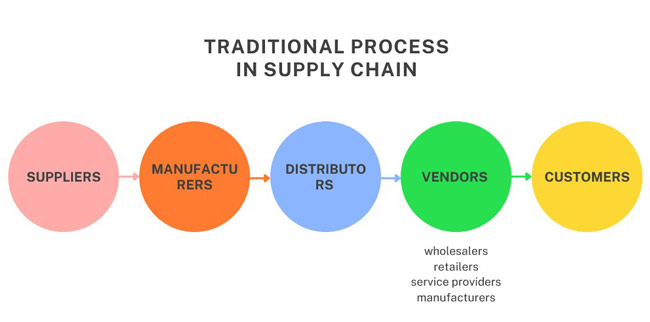
It is worth noting, however, that this flow can vary depending on the specific context, such as outsourcing manufacturing or contract manufacturing.
In real-world scenarios, roles can overlap. Vendors could be wholesalers, retailers, service providers, or manufacturers.
3) An Example of Supply Chain Process
Let’s look at a simplified example from the fashion world:
Company A is a well-known fashion brand. To bring their designs to life, they enlist the expertise of a sourcing agent, Agent B, to manage sourcing and production.
Agent B collaborates with Factory C, which produces the final clothing based on Company A’s specifications. And there will be other suppliers providing fabrics, zippers, and accessories to Factory C.
Throughout the process, Agent B ensures everything runs smoothly before delivering the goods to Company A.
In this process, you will see:
- Suppliers: Provide fabric, trims, and accessories
- Manufacturer: Assembles and makes the final garments
- Vendor: Oversees sourcing and production services
- Company: Sells the finished product under its brand
Part 2. What Is the Difference between Supplier and Vendor?
1. Vendor vs Supplier: Roles in the Supply Chain
Vendor and supplier both play essential roles in the supply chain link that starts with manufacturing the raw materials and ends with delivering the finished goods to the final customer. And the roles they act in are one vendor vs supplier difference.
Vendor: In the entire supply chain, vendors are close to the end of it since they can directly hand over finished goods to retailers or wholesalers for selling to the customers.
Supplier: Suppliers are placed at the early stage in the supply chain, supplying aw materials, components, or parts to the manufacturer to ensure a smooth flow of production.
2. Vendor vs Supplier: Business Relationship
Vendor: Its transactional relationship is focused on selling products or services to customers – individual or business, hence it tends to establish business-to-customer (B2C) and business-to-business (B2B) relationships.
Supplier: Providing primary goods, suppliers mainly deal in relationships with companies to build long-term relationships, thus facilitating B2B partnerships.
3. Supplier vs Vendor: Product Focus
Vendor: Vendors usually don’t participate in the production. Vendors offer a range of products or services to cater to the needs and preferences of their target customers. They may curate a diverse product portfolio or offer a wide range of services to meet various customer demands.
Supplier: Suppliers specialize in providing specific goods or materials, often focusing on a particular niche or industry. They may have expertise in manufacturing specific components or sourcing materials that are crucial for the production process.
4. Supplier vs Vendor: Sales Channels
Vendor: It sells products or services through various channels such as physical stores, online platforms, or third-party retailers. They often emphasize creating an appealing shopping experience, showcasing products, and providing customer support.
Supplier: In a typical scenario, the direct customers of suppliers are other companies, such as manufacturers or vendors. They work through contacts to sell their products in MOQs to manufacturers to maintain a reliable supply chain.
5. Supplier vs Vendor: Business Goals
One difference between vendor vs supplier is their aims.
Vendor: By focusing on marketing and branding, vendors can attract more consumers to maximize sales of goods and make a profit. They are also dedicated to providing services to final customers, which can research and meet the market demands.
Supplier: The primary focus of suppliers is to meet the needs of client companies and establish relationships for further cooperation. Their reputation and relationships with other businesses in the supply chain are crucial for their success.
Part 3. Comparison Chart of Vendor vs Supplier
| Aspect | Vendor | Supplier |
|---|---|---|
| Meaning | A person or company that sells finished goods or services directly to customers | A business that provides goods to another business or organization |
| Role in the Supply Chain | At the penultimate stage in the supply chain before goods go directly to consumers | At the early stage in the supply chain |
| Business Relationship | B2C, B2B | B2B |
| Proximity to End Customers | Direct | Indirect |
| Production | Not involved in production | Involved in production |
| Product Categories | A wide range of goods and services | Specific goods |
| Sale Channels | physical stores, online platforms, or third-party retailers | Other businesses |
| Business Purpose | Sell products or services to meet the market and gain profits, and improve customer satisfaction | Offer products with quality assurance to meet the needs of partners and establish stable relationships |
Part 4. FAQ about Vendor and Supplier
Q1. Is a vendor the same as a supplier?
Not exactly. While both are part of the supply chain, they serve different roles.
A supplier provides raw materials or components to manufacturers, while a vendor sells finished products to end users—either businesses or consumers. Their positions in the supply chain are different.
Q2. Can vendor and supplier be used interchangeably?
In informal conversation, they can be used interchangeably as the terms used are not that strict and sometimes a supplier can be your vendor based on your relationships.
But in practice, especially in manufacturing and regulated industries, it’s important to know the distinction.
A vendor often refers to businesses that provide generic items or services, like office supplies or outsourced services—typically through indirect sourcing.
A supplier can refer to a strategic partner who provides the products you need. They usually undergo strict factory audits, quality checks, and repeated orders.
Q3. Why are suppliers and vendors important in the supply chain?
Suppliers and vendors are indispensable components of the supply chain. Together, they contribute to the smooth and efficient flow of goods and services from production to consumption.
Without suppliers, you have nothing to produce. Without vendors, you have no way to deliver your products to the market.
So when either side breaks down, delays, stockouts, and revenue losses follow quickly. The supply chain disruptions in recent years have taught us all.
Conclusion
Understanding the difference between vendor vs supplier is relatively straightforward once you grasp their respective meanings and positions in the supply chain. They are important parts of the functioning and success of the supply chain ecosystem.
The key elements that differentiate a supplier and a vendor are their roles, customer relationships, product focus, sales channels and business goals.
Backed by more than 2 decades of experience in managing supply chains for various companies, SVI Global possesses a wealth of expertise in all aspects of the supply chain process. Our dedicated team is equipped with the knowledge and skills to handle your orders in a customized manner as per your requirements. You can rely on our services to guarantee that your products meet the highest quality standards and will be shipped to you on time.
If you are planning to venture into overseas manufacturing, partnering with SVI Global is a smart choice to reduce potential risks and achieve your goals efficiently. Our comprehensive solutions and extensive industry experience will help you navigate the challenges of a competitive international supply chain, ensuring compliance with regulations and optimizing operations.


